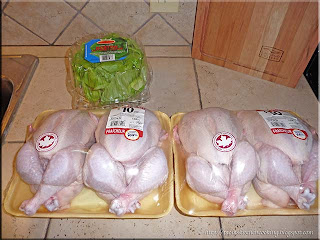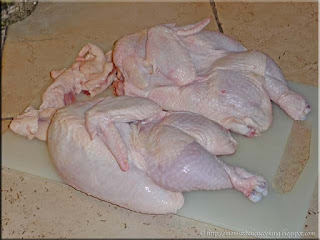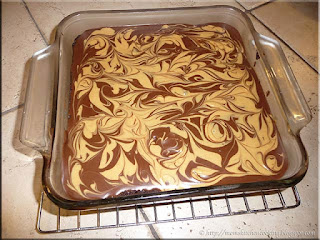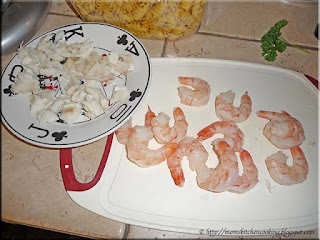Yesterday was a whirlwind of activity here rendering my kitchen inoperable for a little over eleven hours without the clean-up today. I will apologize in advance for the glare on the pictures. This kitchen is absolutely horrid for taking pictures in due to the natural lighting and reflections from the marble tile floor. Our friend who is doing a lot of custom woodworking in our home arrived with his crew of one at 9 AM. Now this is my husband's busy time of the year meaning he works 16 to 18 hours a day. He came up with a plan to skirt some of his DIY projects and that was to get our friend and his crew to do them. At the end of the day, the kitchen bulkhead and trim were finished, the front door was fixed, the replacement garage door opener was installed and I had a nice, new central vacuum cleaner to play with. Had we waited, none of this would have been done until after tax season (April 30) but in reality likely not until after our spring vacation. Anyway, this work was finished in one day and while I didn't get any cooking done, I am pleased with the results.

Marble tile flooring is a bit more on the delicate side than I thought it would be. I can't even use my standard vinegar solution for washing it as the pH needs to be neutral so the steam mop works nicely. The guys protected the floor with a heavy quilted throw. This was to be the kitchen scene for the next almost eleven hours. It doesn't show the two ladders being used or the guys standing with work boots on my counter or even remotely describe the sound of the power nailer powered by the air compressor (bottom centre).
All of the cutting was done in his mobile workshop which is quite impressive! At least most of that mess stayed outside. It was a very long day though!
We moved here last September. The
original kitchen was taupe tones. Our friend made a
custom shelf for my cookbooks giving a home to some of my most used cookbooks. I recently painted
the kitchen the same colour as my dinner plates, a colour that matched nicely into the colour scheme I chose for the house.
The kitchen cabinets had an open bulkhead, the space between the cabinets and ceilings. One of our houses had the same open bulkhead as does our vacation home. When our friend suggested enclosing it, I was all in favour. An open bulkhead is a work-maker, dust collector, and borderline clutter collector. Anyone with an open bulkhead knows it is a greasy dust collector as well. Our friend recommended building in the bulkhead. True we would lose a bit of storage space and we could have designed it to have extra storage but we chose not to.
Pictured is the finished bulkhead along the long wall of the kitchen. There is a slight tone difference in the woods, something our friend is really not happy about but quite frankly I think the new tone suits the kitchen better. In reality, the tone difference shows more in the pictures than it does in the kitchen. At this point we have a few options. We decided to take the kitchen cabinets from their yellow tones to the taupe tones of the new trim. While this does mean more work to be done, the end results will be nicer. Seriously, we dealt with this very same problem at our last house. The fix is not as complex as it sounds. So, the kitchen isn't completely finished but that's ok.

The refrigerator wall of the kitchen had a bank of cabinets separated by jut out wall we cannot change. At first, the plan was to leave that wall with no trim but then I thought it would look better with the same trim. What do you think? This is one good reason why the homeowner should be there when any custom work is being done especially in the kitchen.
All in all, I am quite pleased with building in the bulkhead. While it removes a bit of storage, it removes a dust collector that is much appreciated given my allergies. Ideally, kitchen cabinets should go to the ceiling eliminating this problem entirely but if they don't this is a viable option. In vacation homes that you rent out when not using this is a great spot to build in secured storage for items you don't want your renters to use.
We extended the oak trim around the entire kitchen. This added continuity and character to the kitchen. The deep cove molding added a touch of elegance without being pretentious as well.
This was a very long day of workers in the house. In the end, everything was done that needed to be done that day. True, it has led to more work but that is the nature of any home renovation. The next step is the cabinets, bringing them to the tone of the new bulkhead. And with that the kitchen should be finished but is it? My husband wants to add a sunroom off of the kitchen making that portion of the deck usable three seasons or year round.
This is precisely what happens when two people who love to cook are faced with a brand new kitchen. Nothing happens in one fell swoop and the plans keep getting changed but in the end we get what works for us. I will post a picture of the finished cabinets and keep you updated on the sunroom.










































